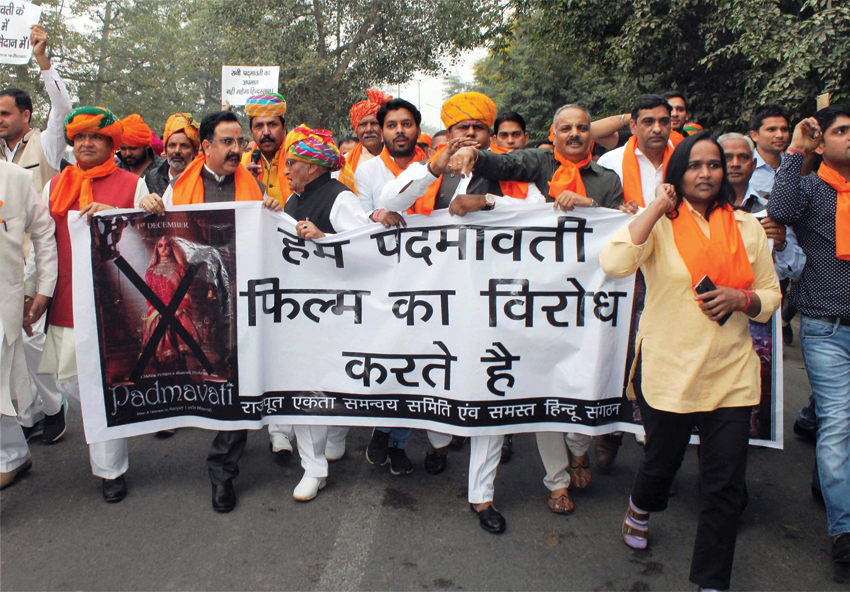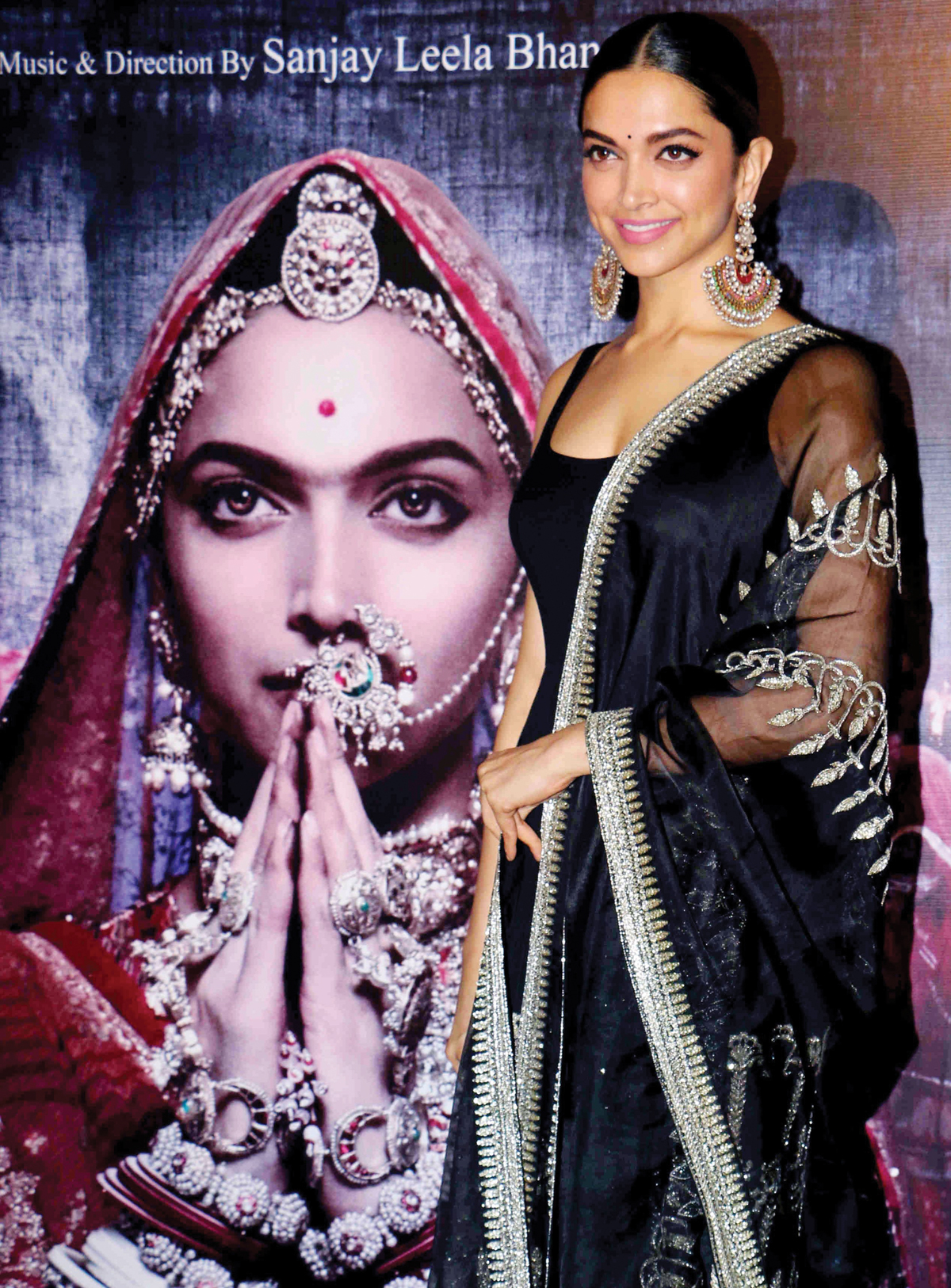A Glimpse of Chittor’s Padmavati – Karni Sena Makes It Difficult
Deepika Padukone poses for a photograph during a promotional event for ‘Padmavati’ directed by Sanjay Leela Bhansali in Mumbai, Oct. 31. (AFP/Getty Images)
Bollywood film director, Sanjay Leela Bhansali’s latest period saga, variously described as a fictional account based on the epic work of medieval Sufi poet Malik Muhammad Jaisi penned in 1540 or a historical venture, “Padmavati,” has landed in a huge controversy, writes Priyanka Bhardwaj.
The result is that the movie has not yet been passed by the Censor Board of Film Certification (CBFC), its producer Viacom18 Motion Pictures has voluntarily deferred its release, initially slated for December 1, and state governments of Gujarat, Uttar Pradesh, Rajasthan, Punjab, Madhya Pradesh and Bihar have banned its theatrical screening even if the CBFC gave it clearance.
While these state administrations have resorted to err on the side of playing safe with not hurting Rajput sentiments, the Supreme Court has come down heavily on the former for blocking the release of the movie and refused to ban it in an appeal demanded for one.
Violent agitations against the movie began a few months ago when some members of the Shri Rajput Karni Sena (SRKS) members manhandled Bhansali during its shooting in Rajasthan.
These Rajput members claimed that Bhansali had distorted and maligned their history by indicating a romance between the derided Mughal Allauddin Khilji and Queen Consort Padmavati of Rana Ratan Singh, the ruler of Chittor.
Though the furor died down temporarily on the assurance of Bhansali that he respects Rajput sentiments and would not distort history, Rajput groups went on a rampage and vandalized the theatre where the trailer was shown.
Protests went overboard when flared up groups and individuals placed a reward of Rs.0.1billion for cutting off the actress, Deepika Padukone’s nose and beheading of Bhansali.
Clearly this was not condoned by any group, political party or ruling center and in the event of a heavy condemnation the BJP leader who made the deplorable calls was forced to resign.
As a mark of protest Dharohar Bachao Samiti with support from Hindu and social organizations has announced “Janta Curfew” in Jaipur on December 1.
With the peaking of protests, Bhansali and Prasoon Joshi, Chief of CBFC, were asked to appear before a Parliamentary Panel where it expressed disappointment with Bhansali for screening the Rs.1.9billion budget film for select journalists before being passed by the regulatory body.

Quite expectedly, the erstwhile ruler of Mewar, Maharana Arvind Singh, 76th custodian of the Mewar dynasty which is the longest serving dynasty of the world, has voluntarily offered to defuse the tensions by mediating if Bhansali desires. In fact, in its latest calls the SRKS has said that if the royal family of Mewar find nothing objectionable in the film then it too will withdraw its protests.
Though he too condoned the violence and threats calls to the lead actors and director, he did not shy away from criticizing the filmmaker from playing up with Rajput sentiments and distorting facts, inaccurately depicting Mewar as a rich state as opposed to the actual facts that heavy military expenditures in the event of frequent enemy attacks had depleted the state treasury that prevented opulent indulgence, and the frivolous depiction of the ritual self-immolation by ladies called “Jauhar.”
Interestingly his claims that the 13th century Padmavati figured amongst his ancestors and such references to her existence in the oral bardic traditions, have been debunked as mere exaggeration by most scholars including Harbans Mukhia, a recognized authority on the subject.
To what extent fact and fiction have been weaved Jayasi’s poem ‘Padmavat,’ around Chittorgarh fort, will always remain a mystery or by some chance discovery of evidence.
But in the eyes of most Indians especially the Rajputs, Padmavati was not just a “Queen” but a “Goddess” and “Mother” and symbolized valor, prestige and identity.
The first mention of Padmavati is found in the English version by Colonel James Tod whose works were considered to be in favor of Rajputs and he speaks of the “mirror version.”
The poem speaks of the obsession of the mighty Delhi Sultan Alauddin Khilji who was on a mission to enslave and possess the wife of the ruler of Chittor.
But when the ruler of Chittor was killed on the battlefield, the queen and all the other women in the fort immolated themselves rather than be enslaved by the sultan in those barbaric ages of mediaeval India.
That Khilji had besieged Chittorgarh Fort that was in the Kingdom of Mewar in 1303 AD when there were instances of ‘Jauhar’ are historical truths but if it was led by Padmavati is yet uncertain.
What is clear is that creative freedom and the freedom of expression of the artist are important tenets guaranteed by the Constitution.
But there are explicit principles such as Article 92 in the Constitution that places reasonable restrictions in specific cases that may have significant or dangerous consequences.
In this case where the government is the upholder of Freedom of Speech as well as maintaining of law and order it may have to be a realist and err on the side of precaution.
Therefore, if there needs to be headway, there will need to be concessions and empathizing of sensitivities from both sides as both rights and freedoms cannot be unconditional.


